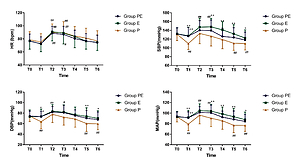Current issue
Archive
Manuscripts accepted
About the Journal
Editorial office
Editorial board
Section Editors
Abstracting and indexing
Subscription
Contact
Ethical standards and procedures
Most read articles
Instructions for authors
Article Processing Charge (APC)
Regulations of paying article processing charge (APC)
PHARMACOLOGY AND PHARMACY / RESEARCH PAPER
Comparison of the combination of propofol and etomidate versus propofol or etomidate alone for induction of general anesthesia: a double-blind, randomized controlled trial
1
The Second Affiliated Hospital of Anhui Medical University, China
2
Anesthesiology and Pain Medi-
cine, University of California Davis Health System, 4150 V St, Suite 1200,
Sacramento, CA 95817, United States
3
Anesthesiology and Pain Medicine, University of California Davis Health System, 4150 V St, Suite 1200,
Sacramento, CA 95817, United States
Submission date: 2020-08-23
Final revision date: 2021-06-04
Acceptance date: 2021-07-02
Online publication date: 2021-07-09
Corresponding author
Hong Liu
Anesthesiology and Pain Medi- cine, University of California Davis Health System, 4150 V St, Suite 1200, Sacramento, CA 95817, United States
Anesthesiology and Pain Medi- cine, University of California Davis Health System, 4150 V St, Suite 1200, Sacramento, CA 95817, United States
KEYWORDS
TOPICS
ABSTRACT
Introduction:
Hemodynamic fluctuation during the induction of general anesthesia is a common event and adversely affect patients’ outcomes. The aim of this study is to investigate the impacts of different anesthesia induction agents: propofol, etomidate, and propofol-etomidate combination on patient hemodynamics and processed electroencephalography (EEG).
Material and methods:
Seventy-five patients undergoing elective non-cardiac surgery were randomly assigned to three groups of anesthesia induction agents: the group P received 2 mg/kg propofol, the group E received 0.3 mg/kg etomidate, and the group PE received the combination of 1mg/kg propofol plus 0.15mg/kg etomidate. Hemodynamic variables and processed EEG were measured during induction.
Results:
Heart rate (HR) was significantly increased at intubation and 1 min after intubation compared with baseline in all three groups. Mean arterial pressure (MAP) decreased significantly after induction, at 5, and 10 min after intubation in group P (79.1±12.6, 77.0±14.2, 76.6±11.4 versus 93.2±9.9 mmHg; all P<0.001). MAP increased significantly at intubation and 1 min after intubation in group E (104.7±13.0, 103.8±12.8 versus 92.9±10.2; P<0.001, P=0.001 respectively). The incidence of myoclonus was lower in groups PE (4.0%) and P (4.0%) compared with that in group E (24.0%) (P=0.033). The incidence of pain at injection was higher in group P (28.0%) than that in groups PE and E (4.0% and 0.0%) (P=0.025).
Conclusions:
The combination of propofol and etomidate used during induction of anesthesia provided a more stable BP profile, less pain at site of injection, and decreased myoclonic movements compared with propofol or etomidate alone.
Hemodynamic fluctuation during the induction of general anesthesia is a common event and adversely affect patients’ outcomes. The aim of this study is to investigate the impacts of different anesthesia induction agents: propofol, etomidate, and propofol-etomidate combination on patient hemodynamics and processed electroencephalography (EEG).
Material and methods:
Seventy-five patients undergoing elective non-cardiac surgery were randomly assigned to three groups of anesthesia induction agents: the group P received 2 mg/kg propofol, the group E received 0.3 mg/kg etomidate, and the group PE received the combination of 1mg/kg propofol plus 0.15mg/kg etomidate. Hemodynamic variables and processed EEG were measured during induction.
Results:
Heart rate (HR) was significantly increased at intubation and 1 min after intubation compared with baseline in all three groups. Mean arterial pressure (MAP) decreased significantly after induction, at 5, and 10 min after intubation in group P (79.1±12.6, 77.0±14.2, 76.6±11.4 versus 93.2±9.9 mmHg; all P<0.001). MAP increased significantly at intubation and 1 min after intubation in group E (104.7±13.0, 103.8±12.8 versus 92.9±10.2; P<0.001, P=0.001 respectively). The incidence of myoclonus was lower in groups PE (4.0%) and P (4.0%) compared with that in group E (24.0%) (P=0.033). The incidence of pain at injection was higher in group P (28.0%) than that in groups PE and E (4.0% and 0.0%) (P=0.025).
Conclusions:
The combination of propofol and etomidate used during induction of anesthesia provided a more stable BP profile, less pain at site of injection, and decreased myoclonic movements compared with propofol or etomidate alone.
Share
RELATED ARTICLE
We process personal data collected when visiting the website. The function of obtaining information about users and their behavior is carried out by voluntarily entered information in forms and saving cookies in end devices. Data, including cookies, are used to provide services, improve the user experience and to analyze the traffic in accordance with the Privacy policy. Data are also collected and processed by Google Analytics tool (more).
You can change cookies settings in your browser. Restricted use of cookies in the browser configuration may affect some functionalities of the website.
You can change cookies settings in your browser. Restricted use of cookies in the browser configuration may affect some functionalities of the website.



